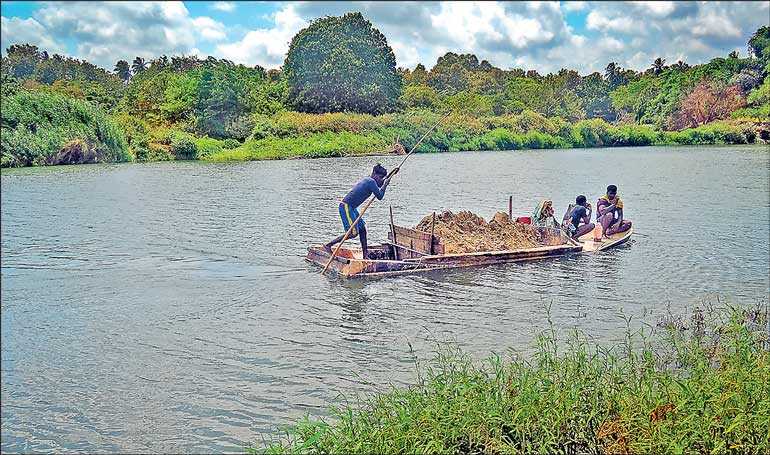Saturday Dec 13, 2025
Saturday Dec 13, 2025
Friday, 31 July 2020 00:00 - - {{hitsCtrl.values.hits}}

In the mining industry, the wider policy concerns in terms of over exploitation of minerals such as sand without sustainable measures to restore and rehabilitate the mines, depict such rent-seeking behaviour. Against such a backdrop, dispensing environmental recommendations of the CEA by the GSMB can only add into the stories of environmental degradation, especially at the hands of illegal mining – Pic courtesy Global Press Institute
The balance between sustainable development and environmental conservation in Sri Lanka is often undercut by the political leadership with policies best explained as short-sighted and environmentally unsound. Owing to this, the nation is caught up in a resource curse, where policies validate  environmental costs in the name of economic development.
environmental costs in the name of economic development.
It is no new truth that the issuance of mining permits for minerals such as sand, soil, clay and gravel generally get caught up in this vicious cycle. In theory, even if the mineral resources in Sri Lanka, are governed by the Mines and Minerals Act No. 33 of 1992 (as amended); in practice it is the politics of the day that gets to call the shots. Since the 4th of December 2019, a number of decisions made by the Sri Lankan Cabinet along with the Geological Survey and Mines Bureau (GSMB), have blatantly disregarded the existing laws, particularly in terms of issuing licenses/permits for mines and minerals.
There are two specific Cabinet decisions which underlies the issue at hand. Firstly, removing the requirement of a license to transport sand, soil, clay, etc. Secondly, the proposal to amend the Mines and Minerals Act, so that the procedure to obtain mining licenses are much “simplified”.
Adding on to the tunnel-vision of the Cabinet decisions, the GSMB dispensed the requirement of environmental recommendations of the Central Environmental Authority (CEA) in issuing licenses/permits. However, on 17 July the Court ordered to take legal action against those transporting sand and rubble without permits, proving that the Cabinet cannot amend and invent laws at its own wish.
Nevertheless, the saga of “relaxing” procedure continues, and the GSMB’s attempts to facilitate industrial and political needs by striking out any and all environmental compliance requirements is appalling and cannot be overlooked.
The crisis: Cabinet and GSMB removing transport permits and dispensing with environmental concerns
The present crisis unfolded on 4 December 2019, where the newly appointed Cabinet of Ministers removed the existing requirement on obtaining permits for the transportation of sand, soil and clay to facilitate the construction industries in securing necessary minerals in an economical manner.
On 18 December 2019 the Cabinet approved the proposal to amend the Section 28 and 30 of the Mines and Minerals Act citing the need to simplify the existing procedure of mining licenses to better facilitate the industrial needs.
It is Section 28 of the Act that mandates a license to mine, transport, process, store, trade in or export any minerals in Sri Lanka. This section ensures that the issuance of a license is done according to the provisions of the Act, making it impossible for the GSMB to singlehandedly execute absolute authority in issuing licenses.
Whilst there were restrictions explicitly mentioned in the Act under sections 29, 30,31 and 38 in terms of issuing licenses; it is section 61 of the Act, that clearly stipulates the requirement of a license holder to comply with the standards and procedures of the National Environmental Act No. 47 of 1980. Thus, protection of the environment cannot be overlooked in granting a license for mining related activities.
Significantly, Section 61 ensured that a link was created between the National Environmental Act and the Mines and Minerals Act as well as the institutions created by these two Acts, namely the CEA and the GSMB. Whilst, this makes the licensing process a coordinated decision between these agencies it also shows that the environmental concerns indispensable.
However, the decisions of the cabinet ministers, which came to effect from the 1st of January 2020, is completely aversive to the law laid down by the Mines and Minerals Act. More seriously, since the cabinet is an executive arm of the Sri Lankan government, it is also collectively accountable for overlooking its duty to protect and promote the environment of Sri Lanka under the Directive Principles of State Policy set out in the Constitution (Article 27).
In the case Watte Gedera Wijebanda v Conservator General of Forests and Others [2009 1 SLR 337 at p. 362], Justice Shiranee Thilakawardena highlighted that, the power of the State and the public officials to grant or refuse licenses is derived from that fact that the State is a “public trustee”. In fact, “[T]he principle of inter-generational equity and the long-term sustainability of our delicate eco-system and biological diversity vests mainly in the hands of such officials”. Thus, the Cabinet and the GSMB is vested with the duty to protect the environment even for the generations to come.
Yet, on 31 December 2019 the Director General of GSMB, indifferent to his duty as a public trustee, issued a Circular (Circular No. 173/12/2019) to amend the procedure of issuing permits/licenses citing the need to prevent any procedural delays in obtaining the licenses. With the new procedure, the GSMB can now issue mining permits/licenses to applicants who have not compiled with environmental recommendations of the CEA.
What the Cabinet and the GSMB probably failed to comprehend was the fundamental reasons underlying the licensing process of utilising environmental resources. Licenses are more than just paper work and procedure. They are issued to regulate and prevent the over exploitation of resources in order to ensure that development does not end up completely dismantling existing eco-systems. Thus, if the Cabinet and the GSMB is of the view that compliance with environment standards is a cause of delay – then the whole rationale behind granting licenses becomes completely obsolete.
Flawed decisions and the resource curse
In the months that unfolded after the cabinet and the GSMB relaxed the regulations pertaining to mining licenses and permits, two main justifications were made in a number of media reports. One was the need to facilitate the industrial demand and ensure that development objectives are not curtailed. The second reason revolves around mitigating illegal mining activities, which according to the GSMB occurs due to the complex procedure that existed before.
However, Dr. Chaminda Samarasuriya, a senior lecturer at the Department of Earth Resources Engineering, University of Moratuwa warned that, relaxing the mining license procedure can completely destroy the riverine eco-systems in Sri Lanka because there is no rigorous system in place to monitor mining or related activities such as transportation.
In his view, the GSMB circular which dispenses the environmental recommendations of the CEA can cause irreparable damage to the eco-systems. He observed that the branches of Mahaweli River, Maha Oya, Deduru Oya, Gin Gaga and even other river branches in the southern part of the island were heavily affected due to irregular mining since December 2019. Dr. Samarasuriya stressed that it was no longer possible to name or measure the specific rivers impacted by illegal mining, because in the last six months illegal mining was at its peak due to the myopic actions of the authorities.
Thus, the real question is whether the justifications of the GSMB can really rationalize the decision to dispense environmental recommendations given for mining permits. Whilst there is a clear issue underlying the legality of all these decisions (including the cabinet and the GSMB), the larger picture pinpoints at a much dire policy failure, which requires a different discussion all together.
The developments in Sri Lanka, particularly GSMB’s move to dispense the environmental
recommendations of CEA in issuing licenses, reflects a classic example of the resource curse, where the policy makers are also part of the problem. The resource curse is experienced by many developing countries endowed with significant natural resources. Too often these resources prove a curse instead of a blessing because in the process of extracting resources there is political corruption, rent seeking and inequitable distribution of the proceeds.
EFL observed multiple instances of irregular mining reported in the immediate aftermath of eliminating the transportation license and the CEA recommendations. For example, in areas such as Sippigalana, Weerakumandaluwa of the Deduru Oya, Sudupaanagala in Wellawaya (Kirindi Oya), Mukkuthoduwawa in Kandakkuliya, Kudarappu in Wadamarachchi Point Pedro, Kayts in Jaffna and in Ging Ganga in Galle, residents have reported that mining for river sand has accelerated due to the removal of transport permits.
Against such evidence, GSMB’s stance on relaxing procedure is clearly flawed. It also shows that one cannot simply ignore larger empirical and policy concerns regarding sand mining and magically wish illegal mining away by simply relaxing the procedure.
Relaxation of procedure and sustainable development
Since mining is one of the most profitable industries contemporarily, political corruption is rampant especially in issuing permits. In fact, GSMB itself is plagued by political patronage and rent-seekers, who continuously attempt to capture economic benefits without substantial contribution to the overall economic production or sustainability.
In the mining industry, the wider policy concerns in terms of over exploitation of minerals such as sand without sustainable measures to restore and rehabilitate the mines, depict such rent-seeking behaviour. Against such a backdrop, dispensing environmental recommendations of the CEA by the GSMB can only add into the stories of environmental degradation, especially at the hands of illegal mining.
It is vital to bear in mind that laws are emphatically multidimensional; a truth that the Sri Lankan policymakers often overlook. This makes the regulation of sand mining, a matter encompassing a range of agencies and policy concerns, including the environment and even water resources.
The ad-hoc decisions of the Cabinet and the GSMB completely overlooks this aspect about the law and the rationale for laws that are currently in place to regulate mining. Thus, the tunnel-vision of policymakers can only intensify the resource curse in Sri Lanka where future generations will have to endure the ramifications of political rent-seekers.
(The opinions expressed are independent. The author can be reached at [email protected].)